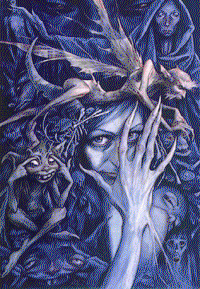As I write this, in a quiet, old farmhouse in the west of Ireland, I can almost hear the echo of voices from the family who used to live here long ago. Behind my house is a large barn, and other buildings from the old dairy farm. Once upon a time, this was a busy, bustling home, even in the dead of winter. Now, all the cows are gone and, in the winter silence beyond the barn, I feed the wild creatures (foxes, rabbits, birds) that dairy farmer would have shot.
It’s the dark of the year, and it can be a really depressing time of year. I have found that it helps to look at the season through the eyes of ancient peoples. Long ago, I suspect people had little time for depression. There was just too much to get done in too few hours of daylight! For Druids, in particular, this dark quiet of the year symbolized the darkness of the womb, where the personality/the self began to take form. It was a most important time – the ‘fallow’ period – a time to rest and nurture the ‘seeds’ of creative thought.
Winter Solstice, birth of the Sun, at Newgrange
At the winter solstice (this year on the 22nd of December), tightly closed seeds sleep inside all of us. But when the sun rises on the 22nd, the time of awakening will begin. Each day will grow longer, with one additional minute of light, then two minutes, then three, and so on. The seed within us unfurls and blossoms to a full flower by the summer solstice.
Now is the time, amid all the busy Christmas preparations, to follow nature and take some time to tune into the deep, dark womb of the year’s midnight – to really feel and enjoy this quiet interval. Failure to do so usually results in colds and flu and illnesses that force us to take a quiet interval. It’s the best time to look back over whatever we’ve accomplished and learned in the past year and evaluate how we wish to proceed. It’s also the absolute best time to fertilize that little seed that waits in the darkness, with plans and goals that will blossom in the coming year.
This time of year brings to mind another custom inherited from the Druids. Mistletoe was considered very sacred, as it was used to heal many things, especially heart conditions. When you think of it that way, the kissing-under-the-mistletoe custom, has much greater meaning. If your heart is involved, a kiss always means more!
As the sun sets on another winter’s day, I wish you all a nurturing Solstice (with plenty of mistletoe kisses!) and a Nollaig Shona (Happy Christmas)!














































